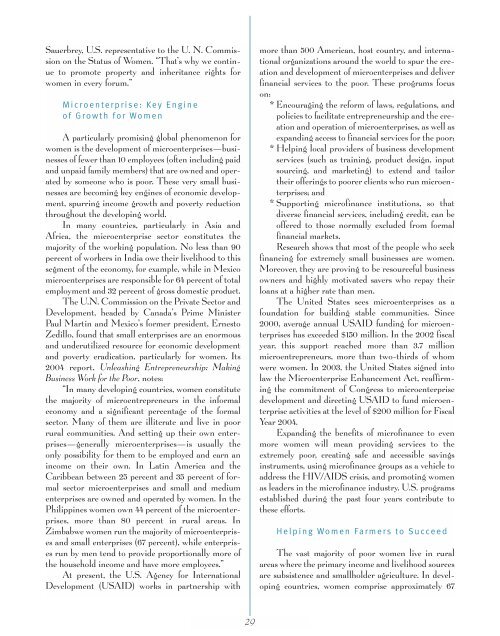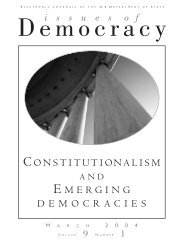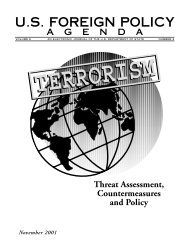Working for Women Worldwide - Embassy of the United States
Working for Women Worldwide - Embassy of the United States
Working for Women Worldwide - Embassy of the United States
You also want an ePaper? Increase the reach of your titles
YUMPU automatically turns print PDFs into web optimized ePapers that Google loves.
Sauerbrey, U.S. representative to <strong>the</strong> U. N. Commission<br />
on <strong>the</strong> Status <strong>of</strong> <strong>Women</strong>. “That’s why we continue<br />
to promote property and inheritance rights <strong>for</strong><br />
women in every <strong>for</strong>um.”<br />
Microenterprise: Key Engine<br />
<strong>of</strong> Growth <strong>for</strong> <strong>Women</strong><br />
A particularly promising global phenomenon <strong>for</strong><br />
women is <strong>the</strong> development <strong>of</strong> microenterprises—businesses<br />
<strong>of</strong> fewer than 10 employees (<strong>of</strong>ten including paid<br />
and unpaid family members) that are owned and operated<br />
by someone who is poor. These very small businesses<br />
are becoming key engines <strong>of</strong> economic development,<br />
spurring income growth and poverty reduction<br />
throughout <strong>the</strong> developing world.<br />
In many countries, particularly in Asia and<br />
Africa, <strong>the</strong> microenterprise sector constitutes <strong>the</strong><br />
majority <strong>of</strong> <strong>the</strong> working population. No less than 90<br />
percent <strong>of</strong> workers in India owe <strong>the</strong>ir livelihood to this<br />
segment <strong>of</strong> <strong>the</strong> economy, <strong>for</strong> example, while in Mexico<br />
microenterprises are responsible <strong>for</strong> 64 percent <strong>of</strong> total<br />
employment and 32 percent <strong>of</strong> gross domestic product.<br />
The U.N. Commission on <strong>the</strong> Private Sector and<br />
Development, headed by Canada’s Prime Minister<br />
Paul Martin and Mexico’s <strong>for</strong>mer president, Ernesto<br />
Zedillo, found that small enterprises are an enormous<br />
and underutilized resource <strong>for</strong> economic development<br />
and poverty eradication, particularly <strong>for</strong> women. Its<br />
2004 report, Unleashing Entrepreneurship: Making<br />
Business Work <strong>for</strong> <strong>the</strong> Poor, notes:<br />
“In many developing countries, women constitute<br />
<strong>the</strong> majority <strong>of</strong> microentrepreneurs in <strong>the</strong> in<strong>for</strong>mal<br />
economy and a significant percentage <strong>of</strong> <strong>the</strong> <strong>for</strong>mal<br />
sector. Many <strong>of</strong> <strong>the</strong>m are illiterate and live in poor<br />
rural communities. And setting up <strong>the</strong>ir own enterprises—generally<br />
microenterprises—is usually <strong>the</strong><br />
only possibility <strong>for</strong> <strong>the</strong>m to be employed and earn an<br />
income on <strong>the</strong>ir own. In Latin America and <strong>the</strong><br />
Caribbean between 25 percent and 35 percent <strong>of</strong> <strong>for</strong>mal<br />
sector microenterprises and small and medium<br />
enterprises are owned and operated by women. In <strong>the</strong><br />
Philippines women own 44 percent <strong>of</strong> <strong>the</strong> microenterprises,<br />
more than 80 percent in rural areas. In<br />
Zimbabwe women run <strong>the</strong> majority <strong>of</strong> microenterprises<br />
and small enterprises (67 percent), while enterprises<br />
run by men tend to provide proportionally more <strong>of</strong><br />
<strong>the</strong> household income and have more employees.”<br />
At present, <strong>the</strong> U.S. Agency <strong>for</strong> International<br />
Development (USAID) works in partnership with<br />
more than 500 American, host country, and international<br />
organizations around <strong>the</strong> world to spur <strong>the</strong> creation<br />
and development <strong>of</strong> microenterprises and deliver<br />
financial services to <strong>the</strong> poor. These programs focus<br />
on:<br />
* Encouraging <strong>the</strong> re<strong>for</strong>m <strong>of</strong> laws, regulations, and<br />
policies to facilitate entrepreneurship and <strong>the</strong> creation<br />
and operation <strong>of</strong> microenterprises, as well as<br />
expanding access to financial services <strong>for</strong> <strong>the</strong> poor;<br />
* Helping local providers <strong>of</strong> business development<br />
services (such as training, product design, input<br />
sourcing, and marketing) to extend and tailor<br />
<strong>the</strong>ir <strong>of</strong>ferings to poorer clients who run microenterprises;<br />
and<br />
* Supporting micr<strong>of</strong>inance institutions, so that<br />
diverse financial services, including credit, can be<br />
<strong>of</strong>fered to those normally excluded from <strong>for</strong>mal<br />
financial markets.<br />
Research shows that most <strong>of</strong> <strong>the</strong> people who seek<br />
financing <strong>for</strong> extremely small businesses are women.<br />
Moreover, <strong>the</strong>y are proving to be resourceful business<br />
owners and highly motivated savers who repay <strong>the</strong>ir<br />
loans at a higher rate than men.<br />
The <strong>United</strong> <strong>States</strong> sees microenterprises as a<br />
foundation <strong>for</strong> building stable communities. Since<br />
2000, average annual USAID funding <strong>for</strong> microenterprises<br />
has exceeded $150 million. In <strong>the</strong> 2002 fiscal<br />
year, this support reached more than 3.7 million<br />
microentrepreneurs, more than two-thirds <strong>of</strong> whom<br />
were women. In 2003, <strong>the</strong> <strong>United</strong> <strong>States</strong> signed into<br />
law <strong>the</strong> Microenterprise Enhancement Act, reaffirming<br />
<strong>the</strong> commitment <strong>of</strong> Congress to microenterprise<br />
development and directing USAID to fund microenterprise<br />
activities at <strong>the</strong> level <strong>of</strong> $200 million <strong>for</strong> Fiscal<br />
Year 2004.<br />
Expanding <strong>the</strong> benefits <strong>of</strong> micr<strong>of</strong>inance to even<br />
more women will mean providing services to <strong>the</strong><br />
extremely poor, creating safe and accessible savings<br />
instruments, using micr<strong>of</strong>inance groups as a vehicle to<br />
address <strong>the</strong> HIV/AIDS crisis, and promoting women<br />
as leaders in <strong>the</strong> micr<strong>of</strong>inance industry. U.S. programs<br />
established during <strong>the</strong> past four years contribute to<br />
<strong>the</strong>se ef<strong>for</strong>ts.<br />
Helping <strong>Women</strong> Farmers to Succeed<br />
The vast majority <strong>of</strong> poor women live in rural<br />
areas where <strong>the</strong> primary income and livelihood sources<br />
are subsistence and smallholder agriculture. In developing<br />
countries, women comprise approximately 67<br />
29












